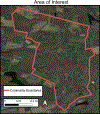Community-based integrated tick management programs: cost and feasibility scenarios
- PMID: 37540592
- PMCID: PMC10862372
- DOI: 10.1093/jme/tjad093
Community-based integrated tick management programs: cost and feasibility scenarios
Abstract
Numerous studies have assessed the efficacy of environmentally based control methods to suppress populations of the blacklegged tick (Ixodes scapularis Say), but few of these estimated the cost of control. We estimated costs for a range of tick control methods (including habitat management, deer exclusion or population reduction, broadcast of acaricides, and use of host-targeted acaricides) implemented singly or in combination and applied to a model community comprising 320 residential properties and parklands. Using the high end for cost ranges, tick control based on a single method was estimated to have mean annual costs per household in the model community ranging from $132 for treating only forest ecotone with a broadcast synthetic acaricide to kill host-seeking ticks (or $404 for treating all residential forested habitat) to >$2,000 for deployment of bait boxes (SELECT TCS) across all residential tick habitat to treat rodents topically with acaricide to kill infesting ticks. Combining different sets of multiple methods in an integrated tick management program placed the annual cost between $508 and 3,192 annually per household in the model community, underscoring the disconnect between what people in Lyme disease endemic areas say they are willing to pay for tick control (not more than $100-150 annually) and the actual costs for tick control. Additional barriers to implementing community-based tick management programs within residential communities are discussed.
Keywords: Amblyomma; Ixodes; control; cost; tick.
© The Author(s) 2023. Published by Oxford University Press on behalf of Entomological Society of America. All rights reserved. For permissions, please e-mail: journals.permissions@oup.com.
Figures
References
-
- Beck A, Bjork J, Biggerstaff BJ, Eisen L, Eisen R, Foster E, Signs K, Tsao JI, Kough E, Peterson M, et al. Knowledge, attitudes, and behaviors regarding tick-borne disease prevention in Lyme disease-endemic areas of the Upper Midwest, United States. Ticks Tick Borne Dis. 2022:13(3):101925. 10.1016/j.ttbdis.2022.101925 - DOI - PMC - PubMed
-
- Bloemer SR, Mount GA, Morris A, Zimmerman RH, Barnard DR, Snoddy EL. Management of lone star ticks (Acari: Ixodidae) in recreational areas with acaricide applications, vegetative management, and exclusion of white-tailed deer. J Med Entomol. 1990:27:543–550. - PubMed
-
- Bron GM, Lee X, Paskawitz SM. Do-it-yourself tick control: granular gamma-cyhalothrin reduces Ixodes scapularis (Acari: Ixodidae) nymphs in residential backyards. J Med Entomol. 2020:58:749–755. - PubMed
-
- Brown JE, Miller TM, Machtinger ET. Tick tubes reduce blacklegged tick burdens on white-footed mice in Pennsylvania, USA. J Appl Entomol. 2020:144(6):542–545. 10.1111/jen.12758 - DOI
Publication types
MeSH terms
Substances
Grants and funding
LinkOut - more resources
Full Text Sources
Medical


